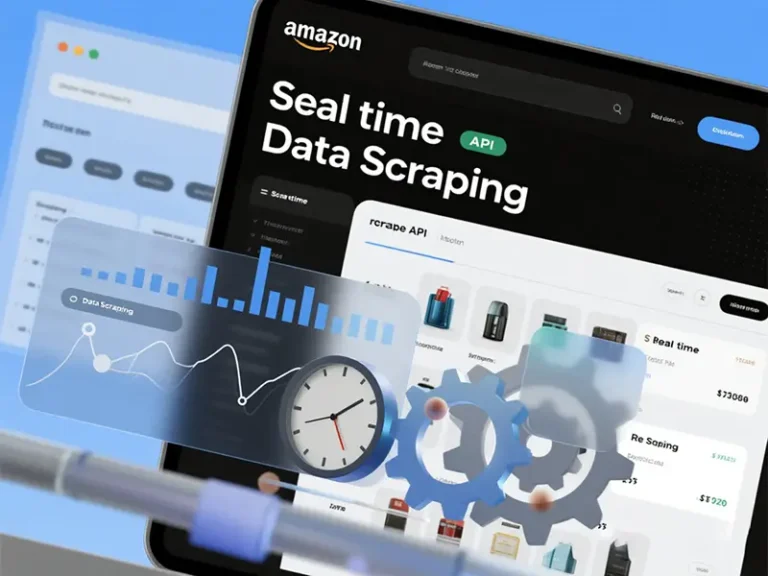In the fierce competition of the e-commerce industry, the Amazon real – time crawler tool is no longer an “optional tool” but a “must – have weapon” for enterprises to seize market opportunities. For Amazon sellers, brand owners, or data analysis institutions, the ability to obtain real – time data such as product prices, inventory, reviews, and ranking lists directly determines the flexibility of pricing strategies, the accuracy of inventory management, and the timeliness of competitor monitoring. However, most traditional Amazon data collection tools often fall short when faced with the complex and dynamically changing page structure of Amazon. This article will deeply analyze the fatal drawbacks of traditional tools and reveal how Scrape API redefines the efficiency standards of e-commerce data collection with its unique real – time advantages.
I. The “Real – time Trap” of Traditional Amazon Data Collection Tools
Before discussing the advantages of Scrape API, we must face a reality: most traditional Amazon data collection tools have insurmountable “real – time obstacles” in their design logic. These tools seem to be able to complete data crawling, but in actual business scenarios, their lag and instability often cause enterprises to miss key business opportunities.
1. The page structure “collapses as soon as it changes”, making real – time collection an empty talk
Amazon will adjust the page DOM structure irregularly to improve user experience and anti – crawler capabilities. It may be the renaming of a tag or the modification of a section of JS rendering logic. Traditional tools rely on fixed XPath or CSS selectors to parse data. Once the page structure changes, the parsing rules will immediately fail.
A cross – border e-commerce brand once reported that the traditional crawler tool it used suddenly could not crawl the “promotion tag” and “inventory status” fields after a regular page update on Amazon. It took the technical team 3 days to find out that Amazon had moved the relevant data from <div class=”promo”> to <span data – promo=”true”>, and the parsing logic of the traditional tool completely relied on fixed tags, resulting in a nearly 1 – week interruption in data collection. During this period, the brand missed the best time to adjust prices because it could not keep track of competitors’ promotion information in real time, directly losing more than $100,000 in sales.
2. Data delay of several hours or even days, missing fleeting business opportunities
The “batch crawling + scheduled update” mode of traditional tools is essentially a compromise on “real – time performance”. For example, a tool is set to crawl Amazon’s best – selling list data every 6 hours, but during e – commerce promotions, the ranking, price, and inventory of best – selling products may change every 10 minutes.
During Amazon Prime Day in 2024, a wireless headphone jumped from the 50th place to the 3rd place on the best – selling list within 2 hours, with the price dropping from \(79.99 to \)59.99 and the inventory changing from “in stock” to “only 5 left”. However, a competing brand relying on traditional tools did not obtain this data until 6 hours later. By then, the headphones had been sold out, and the competitor missed the opportunity to follow up with price reductions. This “data time difference” in the ever – changing e – commerce battlefield is almost equivalent to “passive 挨打”.
3. The maintenance cost of parsing logic is high, which is difficult for small and medium – sized enterprises to bear
Users of traditional tools must be equipped with a professional technical team to continuously track changes in Amazon’s page structure and manually update parsing rules. A third – party survey shows that enterprise users of traditional Amazon data collection tools spend an average of 30 person – days per month maintaining parsing logic, with an annual cost exceeding 500,000 yuan.
For small and medium – sized enterprises, this is an unbearable burden. Many enterprises are therefore forced to reduce the frequency of data collection or abandon some key fields (such as real – time promotion logos, inventory warnings), resulting in incomplete data dimensions and insufficient decision – making basis. What’s more, when Amazon adjusts multiple page structures at the same time (such as product detail pages, keyword search pages, and best – selling lists), traditional tools may take weeks to fully repair, during which data collection is in a “semi – paralyzed” state.
II. The Real – time Advantages of Scrape API: A Comprehensive Breakthrough from Technology to Business
Faced with many drawbacks of traditional tools, Scrape API has transformed “real – time performance” from a concept into achievable business value through underlying technological innovation and architectural design. Its core logic is not simply to increase the crawling frequency, but to realize the closed loop of “data collection and immediate use” through intelligent adaptation, dynamic parsing, and efficient response.
1. Dynamically compatible with page changes, realizing “zero interruption” in data collection
The core technological breakthrough of Scrape API lies in its intelligent recognition algorithm – it does not rely on a fixed DOM structure, but automatically identifies key data (such as title, price, rating, etc.) on Amazon pages through semantic analysis and feature extraction. When the page structure changes, the system can re – locate the data position within milliseconds to ensure the continuous collection process.
For example, when Amazon moves the “price” field on the product detail page from <span class=”price”> to <div data – price=”true”>, traditional tools will return null values due to mismatched tags, while Scrape API can automatically lock the new field position through the characteristics of the price value (such as with a $ symbol, two decimal places) and the page context, and continue to return accurate data. This “dynamic adaptation” capability enables Scrape API to be compatible with more than 99% of regular page adjustments on Amazon, fundamentally solving the problem of “collapsing as soon as changes occur”.
In addition, the technical team of Scrape API will actively adapt to major structural adjustments of Amazon (such as page revision) through weekly iterative updates. Users’ submitted needs for special fields (such as “limited – time flash sale logo”, “seller service rating”) will enter the technical evaluation queue, and the parsing logic can be developed in as fast as 7 days to ensure that the data dimensions continue to meet business needs.
2. Real – time data interface with millisecond – level response speed
Scrape API realizes “immediate access upon call” through the synchronous interface: after developers call the interface, the system immediately initiates a data request, with an average response time of only 200 – 500ms, which is much lower than the “minute – level” or even “hour – level” delay of traditional tools. This means that when the price of a product on Amazon changes, users can obtain the latest data within 1 second to support immediate decision – making.
For example, during the Black Friday promotion, a brand used the synchronous interface of Scrape API to collect the prices of 100 competing ASINs every 5 minutes. When it was detected that a competitor suddenly reduced the price of a certain headphone by 15%, the system immediately triggered an early warning, and the brand’s operation team completed the price adjustment and promotion copy modification within 10 minutes. Finally, the sales volume of the product increased by 230% on that day. This “real – time monitoring + rapid response” mode is a direct business manifestation of the real – time performance of Scrape API.
For scenarios requiring batch collection, the batch submission task interface of Scrape API also maintains high efficiency. Users can submit multiple URLs at one time (such as 100 product detail pages), and the system will process the requests in parallel, with an overall time consumption of no more than 10 seconds. Moreover, the returned data of each URL is a real – time crawling result, avoiding the problem of old data caused by the “cache first and then return” mode of traditional batch tools.
3. Synchronous output of structured data and original data to meet diverse needs
The real – time performance of Scrape API is not only reflected in speed but also in the flexibility of data forms. It supports the simultaneous return of original HTML, Markdown format, and structured JSON data to meet the immediate needs of different business scenarios:
- The original HTML is suitable for scenarios requiring in – depth analysis of page elements (such as custom parsing of special fields);
- The Markdown format is convenient for quick preview and lightweight processing (such as embedding in reports or documents);
- The structured JSON data can be directly connected to enterprise ERP and BI systems to realize immediate application of data (such as inventory warning, price comparison).
Taking the collection of Amazon product detail pages as an example, after users call Scrape API, they can obtain the following at the same time within 1 second:
- Original HTML: including all elements of the page, for the technical team to conduct secondary parsing;
- Markdown text: clearly displaying key information such as product descriptions and parameters, facilitating quick browsing by operators;
- JSON data: including structured fields such as asin code, price, inventory, and the number of reviews, which are directly synchronized to the pricing system to automatically trigger pricing rules.
This “multi – format synchronous output” capability shortens the process from data collection to application to the minute level, greatly enhancing the business value of real – time data.
4. Covering multiple sites, extending real – time advantages to the entire e – commerce ecosystem
The real – time performance of Scrape API is not only for Amazon but also covers mainstream e – commerce platforms such as Walmart, Shopify, Shopee, and eBay. For example, when collecting Walmart product detail pages, its response speed is the same as that of Amazon (average 300ms), and the supported fields (such as product ID, real – time inventory, shopping cart status) are also updated in real – time.
This means that cross – border e-commerce enterprises can monitor the dynamics of competitors on multiple platforms in real – time through a set of API interfaces. A seller operating on both “Amazon + Walmart” platforms once reported that after using Scrape API, they could obtain the price difference, inventory comparison, and review changes of the same product on the two platforms within 5 minutes, so as to formulate differentiated operation strategies. When the inventory on Walmart is insufficient, they immediately increase the promotion efforts on Amazon, resulting in an 18% increase in overall monthly sales.
III. How Can Real – time Performance Empower the Growth of E – commerce Business?
The real – time advantages of Scrape API will eventually be applied to specific business scenarios and transformed into quantifiable growth drivers. From price monitoring to inventory management, from competitor analysis to trend prediction, real – time data is reshaping the decision – making logic of e – commerce.
1. Price monitoring: capturing price adjustment actions in real – time to seize the initiative in pricing
On the Amazon platform, price is a core factor affecting conversion rates, and changes in competitors’ prices are often sudden (such as limited – time discounts, inventory clearance). The real – time collection capability of Scrape API enables enterprises to capture these changes in the first place and quickly adjust their own pricing strategies.
A 3C product seller monitored the prices of 10 core competitors through Scrape API and set an “early warning when competitors’ prices drop by more than 5%”. During a platform promotion, a competitor suddenly reduced the price of a certain headphone from \(89.99 to \)69.99 (a 22% drop). Scrape API captured this change in 3 seconds and triggered an early warning. The seller immediately reduced the price of its own same – type headphone from \(94.99 to \)74.99, maintaining a price advantage while avoiding profit losses due to excessive price reduction. In the end, the sales volume of this seller during the promotion was 1.5 times that of the competitor, and the profit margin was 3 percentage points higher.
2. Inventory and shopping cart status tracking: avoiding the risk of out – of – stock or “empty listing”
The “shopping cart status” (whether in stock, inventory quantity) on Amazon directly affects Listing weight and conversion rates. Due to data delay, traditional tools often lead enterprises to misjudge inventory status – when a product is actually out of stock, the tool still shows “in stock”, resulting in failure to deliver after users place orders, affecting store ratings.
Scrape API can accurately reflect the product inventory status by capturing fields such as “whether there is a shopping cart” and “delivery time” in real – time. A household goods seller monitored the inventory of its 200 Listings through Scrape API. When the system detected that “only 5 pieces of a certain mattress are left in stock”, it immediately triggered a replenishment reminder and temporarily reduced the advertising efforts for the product to avoid “overselling”. Data showed that after using Scrape API, the “order cancellation rate” of the seller dropped from 3.2% to 0.8%, and the store rating increased from 4.2 stars to 4.7 stars.
3. Tracking the dynamics of ranking lists: mastering hot – selling and new product trends in real – time
Amazon’s “bestseller list” and “new product list” are updated every hour, reflecting the latest market trends. Traditional tools crawl once or twice a day, often only showing “outdated trends”, while the real – time collection capability of Scrape API enables enterprises to capture the “dynamic change trajectory” of the ranking lists.
A beauty brand crawled the “new product list” every 30 minutes through Scrape API and found that a certain lip glaze jumped from the 50th place to the 10th place within 6 hours after its launch, with the number of reviews increasing rapidly (20 new positive reviews per hour). The brand immediately analyzed its product selling points (matte texture, niche color number) and adjusted the promotion copy of its own new product within 24 hours, focusing on highlighting similar selling points. Finally, the new product entered the top 20 of the new product list 3 days after its launch, saving nearly 50% of the promotion cost.
IV. Why Choose Scrape API? Full – chain Guarantee from Technology to Service
The real – time advantages of Scrape API are not accidental but are based on multiple guarantees of technical architecture, service system, and ecological adaptation. For enterprises, choosing Scrape API is not only choosing a tool but also a set of “real – time data – driven” e – commerce decision – making solutions.
1. Technical architecture: distributed crawler + intelligent parsing engine
Scrape API adopts a distributed crawler cluster, which can cope with Amazon’s anti – crawler mechanism and ensure stability in high – concurrency scenarios. Its underlying parsing engine integrates machine learning algorithms, which continuously optimize the field recognition model by analyzing massive historical page data, keeping the accuracy of data extraction above 99.5%. Even in the face of Amazon’s temporary anti – crawler strategies (such as IP restrictions, captchas), the system can automatically switch proxy IPs and recognition modes to ensure the continuous collection process.
2. Usability: quick call with API key, zero development threshold
The access process of Scrape API is extremely simple: users only need to register to obtain an API key, and can quickly call the interface through the Base URL (http://scrapeapi.pangolinfo.com) and Bearer authentication. Whether it is a synchronous interface, an asynchronous interface, or a batch interface, detailed request examples (such as curl commands) are provided. Developers do not need to learn complex documents and can complete the access within 10 minutes.
For non – technical personnel, they can use it with Data Pilot (a visual configuration tool): select the fields to be collected (such as price, number of reviews) through drag – and – drop operations, and the system automatically generates API call codes, truly realizing “zero – code collection”. The operation team of a traditional foreign trade enterprise completed the data collection of Amazon keyword search pages through Data Pilot in only 1 hour without technical personnel, greatly reducing the use threshold.
3. Service support: iterative upgrading driven by needs
The technical team of Scrape API is guided by “business demand – driven”. Any requests for special fields submitted by users (such as “Amazon SP advertising logo”, “product parameter table”) will enter the evaluation queue and be iteratively updated every week through an agile development process. This “user demand directly determines function upgrading” mode ensures that the tool is always in line with actual business scenarios.
For example, a user proposed the need to capture the “Climate Pledge Friendly” logo of Amazon products. The technical team completed the development of the parsing logic within 5 working days and synchronously updated it to the API. Users can obtain the field data without any additional operations. This rapid response capability allows the real – time advantages of Scrape API to continue to extend.
Conclusion: Real – time Data is Redefining the Rules of E – commerce Competition
In the e – commerce industry, “speed” is as important as “accuracy”. The lag and high cost of traditional data collection tools can no longer meet the needs of enterprises for real – time decision – making. Through technological innovations such as dynamic adaptation, millisecond – level response, and multi – format output, Scrape API has integrated “real – time performance” into every link of data collection, not only solving the problem of “whether data can be collected” but also answering the core demands of “whether data can be used and used in a timely manner”.
For Amazon sellers, brand owners, or data analysis institutions, choosing Scrape API is essentially choosing a competitive strategy of “winning by data speed”. When your competitors are still waiting for old data from 6 hours ago, you have already completed 3 price adjustments, 2 inventory adjustments, and 1 advertising optimization through real – time information. The advantages brought by this “decision – making time difference” will eventually be transformed into continuous growth in market share.
In the future, with the accelerated iteration of e – commerce platforms, the importance of data real – time performance will become increasingly prominent. Scrape API will continue to extend its real – time advantages to more scenarios (such as live e – commerce data collection, social media e – commerce monitoring) through technical iterations, providing enterprises with more comprehensive real – time data support.




